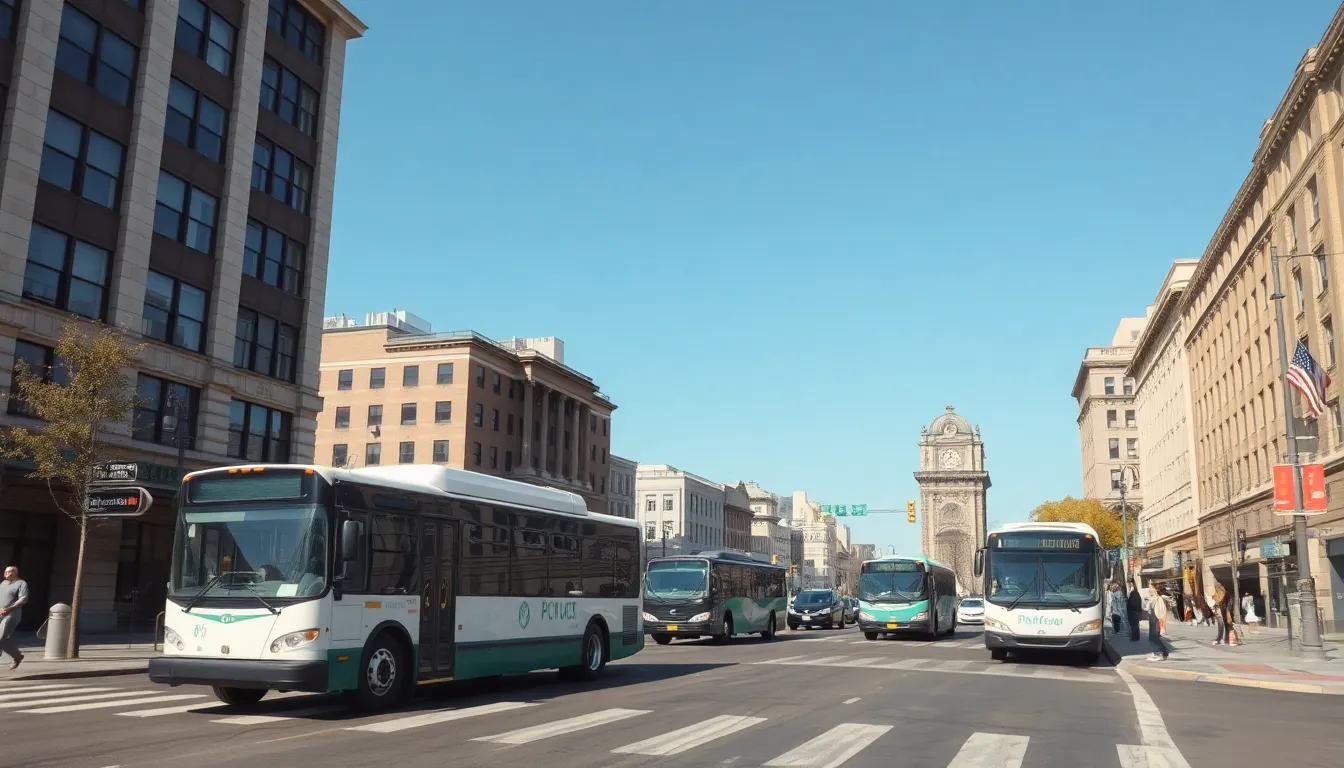Imagine a world where your daily commute is smoother than a well-oiled machine and you can finally enjoy your morning coffee without the stress of traffic jams. Enter AI-powered transportation systems, the superheroes of modern travel. These intelligent systems are revolutionizing how people and goods move, making transportation not just smarter but also more efficient.
Table of Contents
ToggleOverview of AI-Powered Transportation Systems
AI-powered transportation systems enhance the efficiency of daily travel, transforming traditional methods into advanced solutions. These systems leverage intelligent technologies to streamline the movement of individuals and goods.
Definition and Importance
AI-powered transportation systems integrate artificial intelligence within various transport sectors. They’re crucial for optimizing routes, reducing congestion, and improving safety metrics. Cities experience improved mobility, benefitting from predictive analytics that decrease travel times. Users gain more reliable transit options that enhance overall user experience. Environmental impacts decrease due to reduced emissions and fuel consumption, demonstrating sustainability in transportation.
Key Technologies Involved
Numerous technologies drive AI-powered transportation systems. Machine learning algorithms analyze vast datasets to predict traffic patterns effectively. Deep learning enhances image recognition, enabling autonomous vehicles to navigate their environment safely. Natural language processing facilitates communication between users and systems. Connected vehicle technology allows for real-time data exchange among vehicles and infrastructure. Additionally, sensor technology monitors vehicle performance and surroundings, ensuring safer travels. Together, these technologies create an interconnected transportation ecosystem, improving efficiency and safety while reducing operational costs.
Benefits of AI-Powered Transportation Systems

AI-powered transportation systems create a range of advantages that enhance the overall travel experience. These systems prioritize safety and efficiency, making public and private transit more reliable and user-friendly.
Enhanced Safety Measures
Enhanced safety measures become a key benefit of AI-powered transportation. AI systems use advanced algorithms to analyze data from sensors and cameras, enabling real-time identification of potential hazards. Predictive analytics plays a vital role, as it anticipates accidents before they happen, minimizing the risk of collisions. Additionally, autonomous vehicles utilize AI to make split-second decisions, reducing human error, which accounts for approximately 94% of traffic accidents. Safety protocols benefit from continuous monitoring, ensuring that maintenance issues are identified and addressed promptly. This comprehensive approach leads to reduced injuries and fatalities on the roads, creating safer travel environments for all.
Improved Efficiency and Traffic Management
Improved efficiency and traffic management significantly optimize urban mobility. AI algorithms analyze traffic patterns, enabling dynamic routing that involves real-time adjustments based on congestion levels. For instance, traffic signals adapt automatically, reducing wait times at intersections. Optimized public transit schedules enhance punctuality and frequency, making it easier for commuters to rely on available services. In numerical terms, cities report up to a 30% reduction in travel times due to AI-driven strategies. Furthermore, emissions decrease with better traffic flow, contributing to cleaner air in urban centers. Overall, these systems ensure a seamless travel experience while maximizing the use of existing infrastructure.
Challenges in Implementing AI-Powered Transportation Systems
Implementing AI-powered transportation systems presents various challenges that need addressing for effective deployment.
Technical Limitations
Technical limitations often hinder the full potential of AI in transportation. Systems rely on accurate data from sensors and cameras, which can suffer from malfunctions or inaccuracies. Furthermore, integration of diverse technologies across different transport modes creates compatibility issues. High costs associated with upgrading infrastructure can deter swift adoption. Algorithms require substantial amounts of data to train effectively, which may not always be available. Additionally, processing this data in real-time demands significant computational power, straining existing systems. Solutions to these problems require ongoing research and investment in robust technologies.
Ethical and Privacy Concerns
Ethical and privacy concerns significantly impact the acceptance of AI in transportation. The collection and analysis of vast amounts of personal data raise questions about consent and data security. Misuse of information can lead to breaches affecting individual privacy. Algorithms can perpetuate biases within transportation systems if not carefully monitored and assessed. Transparency in decision-making processes is crucial for public trust. Ensuring that AI systems operate fairly necessitates the development of comprehensive ethical guidelines. Stakeholders must prioritize user rights and protection to foster confidence in AI applications.
Case Studies of AI-Powered Transportation Systems
AI-powered transportation systems demonstrate significant advancements across various sectors. Numerous implementations showcase their effectiveness in enhancing mobility, efficiency, and safety.
Successful Implementations
Boston’s Smart Traffic Management System uses AI to reduce congestion. Algorithms analyze traffic patterns and adjust signals, achieving a 20% decrease in wait times during peak hours. Autonomous shuttle services in Las Vegas offer reliable first-mile and last-mile connections, demonstrating AI’s potential to supplement public transit. Additionally, cities like Singapore employ AI to optimize bus routes, increasing efficiency by up to 10%. Embracing these innovative technologies leads to improved transportation experiences for users.
Lessons Learned from Failures
Failing to account for data accuracy proved detrimental in some trials of AI-powered systems. Misinformed algorithms led to incorrect traffic predictions in San Francisco, resulting in increased congestion. Furthermore, challenges arose when cities lacked infrastructure to support advanced technologies, leaving projects stalled. Privacy issues also emerged in trials where user data collection raised concerns about consent. Addressing these pitfalls requires a focus on robust data systems and transparent user policies to enhance trust.
Future Trends in AI-Powered Transportation Systems
Emerging trends in AI-powered transportation systems promise to enhance mobility and urban infrastructure. Predictions indicate significant advancements in connected vehicle technology, enabling seamless communication between vehicles and infrastructure. These innovations lead to improved traffic flow, reducing congestion in cities.
Innovations on the Horizon
Robotic delivery systems are set to revolutionize last-mile logistics, making shipping faster and more efficient. AI algorithms enhancing traffic signal timing are expected to decrease wait times at intersections, increasing overall traffic efficiency. Additionally, advancements in electric and autonomous vehicles support the transition to more sustainable transport options. Increased use of drones for deliveries can optimize supply chains by cutting delivery times. Enhanced real-time data analytics are poised to improve predictive maintenance practices, reducing vehicle downtime.
Potential Impact on Urban Planning
AI-powered transportation systems reshape urban design by informing infrastructure decisions through data-driven insights. Planners can analyze traffic patterns to develop optimized transit routes, significantly enhancing public transport accessibility. Moreover, the integration of smart technologies into urban spaces promotes greener environments through reduced emissions. Cities are expected to allocate street space more efficiently, potentially prioritizing pedestrian and cycling areas. These changes lead to healthier urban living conditions and improved quality of life for residents.
AI-powered transportation systems are poised to reshape urban mobility in significant ways. By enhancing safety efficiency and environmental sustainability these systems promise a future where commuting is less stressful and more reliable. The integration of advanced technologies not only streamlines traffic management but also fosters a cleaner environment.
While challenges remain in implementation and ethical considerations must be addressed the potential benefits far outweigh the obstacles. As cities continue to invest in these innovations the vision of a smarter interconnected transportation ecosystem is becoming a reality. This evolution will ultimately lead to improved quality of life for urban residents and a more sustainable future for transportation.


